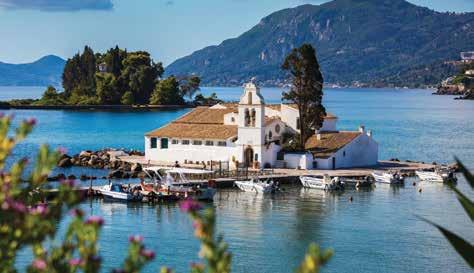
3 minute read
Introduction - A 2,ΟΟΟ-year spiritual journey into the Light of Christian Faith
Introduction - A 2,ΟΟΟ-year spiritual journey into the Light of Christian Faith 3 - 2,000 years of Ceaseless Monasticism 6 - 2,000 years of Living Religious Tradition 8 World Pilgrimage Destinations in Greece 10 - In the Steps of the Apostle Paul - A Route of Faith and History 12 - Mount Athos - The Ark of Orthodoxy 14 - Meteora - The Sacred Rocks 16 - Patmos Holy Island - God’s Apocalypse in Greece 18 Monasteries - Participating in the Monastic Life 20 The Saints in the Worship Life of the Church - the Miracles and their Holy Relics 22 Holy Pilgrimage Sites and Icons of Virgin Mary throughout Greece 24 - Virgin Mary (Panagia) in the Aegean 25 Hellenic Monastery Cuisine - Monastery Products 26 Religious Celebrations and Festivals - Weddings and Christenings 28 The Catholic Church in Greece - Centuries of Spiritual Coexistence 30 UNESCO Monuments 32 Appendix 34
N.B. Agios-Agia (meaning Saint in Greek) has been retained in most names in order to keep the phonetic information as close as possible to the original text.
Toplou Monastery, Siteia, Crete

Wherever you are in Greece, God is on your side… monasteries, holy heirlooms, saints’ holy relics, spiritual struggles and sacrifices, centuries of habits and customs. Christian history and tradition are kept alive at every corner of the country.


Since the emergence of Christianity in history, Greece and the Greek language were the top means of dissemination of the new faith. Ever since, Greek culture and Christian faith have coexisted in a constant, living course through the time, the history and the tradition of this country.
Early Christianity. In Greece, Christ’s disciples, Andrew and Philip, but above all, the Apostle to the Nations, Paul, founded the first Christian church communities in the European continent. Apostle and Evangelist John writing the Book of the Apocalypse on the holy island of Patmos. In Greece – at Filippoi, Macedonia – St. Lydia the Philippian accepts baptism and becomes the first European Christian woman; great martyr figures emerge, such as Saint Dimitrios at Thessaloniki.
The Byzantine Period – the 1,000-year peak of Christian faith. Christian worship, arts and literature, in all their aspects, reach their peak. Ecumenical councils, big and small churches, monasteries, icons, relics, heirlooms of high cultural, religious and artistic value, many of which are listed in UNESCO World Heritage list, can be visited in every part of the country.
The post-Byzantine period – Ottoman Occupation – foundation of the modern Greek state. During the Ottoman rule, Greeks’ devotion to church and their faith were constant and ceaseless, as proven by the number of new martyrs. Saint Kosmas the Aetolian, one of the most active figures of the large number in the modern Greek martyrology holds a prominent position. The Church, through worship and education, served as the main body of rescue of the Christian faith, the Greek language, and Greek cultural heritage. The contribution of the Greek clergy in the national struggle for Independence, was huge and unique; monuments have been erected as a tribute throughout the country.

Detail of mosaic of Archangel

Prevelis Monastery, Crete












